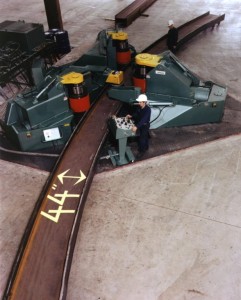Bender/rollers are often asked the question, “Do you curve big beams?”, or “What is the largest beam you can curve?” The bender/roller will respond with a few questions of his own, “What size beam is it?”, “Is the beam rolled the easy way or the hard way?” and “What is the radius?”. The reply to these questions usually is surprising, specifically related to the question of “big beams”. Before we discuss the answers to the aforementioned questions, let us review briefly what is meant by the term “beams”, specifically steel beams.
There are different beam designations, but our focus will be on steel wide flange beams. Wide flange beams range in size from a W4 x 13 to a W44 x 335. The “W” designates that it is a wide flange beam. The number that follows the “W” (4 to 44) is the nominal depth of the beam in inches. The next number is the weight of the beam per one foot in length. Thus, a W4 x 13 would have a nominal depth of four inches and a weight of 13 lbs. per foot. For a complete list of beams produced please visit the AISC website. http://www.aisc.org/WorkArea/showcontent.aspx?id=34922
There are 272 wide flange beams listed in the AISC manual (14th edition). Most of the beams listed are produced domestically. However, there are 17 wide flange beam sizes that are only produced overseas.
There are many variables that structural engineers consider in designing the proper beam size. The most obvious would be the unsupported span of the beam, the loads (dead loads and live loads) which the beam will need to support, and the beam spacing. In addition to these parameters, the architect may have a specific depth of section desired, which is based on their design to achieve a desired aesthetic appearance.
Back to our original question of curving “big steel beams”. The steel fabricator has determined that the beams will be rolled the hard way (in the strong or x-x axis). Next is the beam size. For one steel fabricator, a W12 x 40 would be considered a “big beam”, for another fabricator, it may be a W24 x 55 and for yet another fabricator, it may be a W36 x 135. I took a quick poll in our office and shop asking “What would you consider a “big beam?”” The answers varied greatly from W8’s to W36’s. I asked the operator of the world’s largest beam bender the same question. I would guess that he has curved more big beams than anyone else in North America! His response was W24’s, which is what I would consider a “big beam” as well.
Regarding the minimum radius to which a specific size wide flange beam can be curved the hard way, using the cold bending method, I will address that in my next blog. I will use specific examples from a few projects in which big beams (W24’s and larger) were rolled the hard way.

[maxbutton id=”1″]







